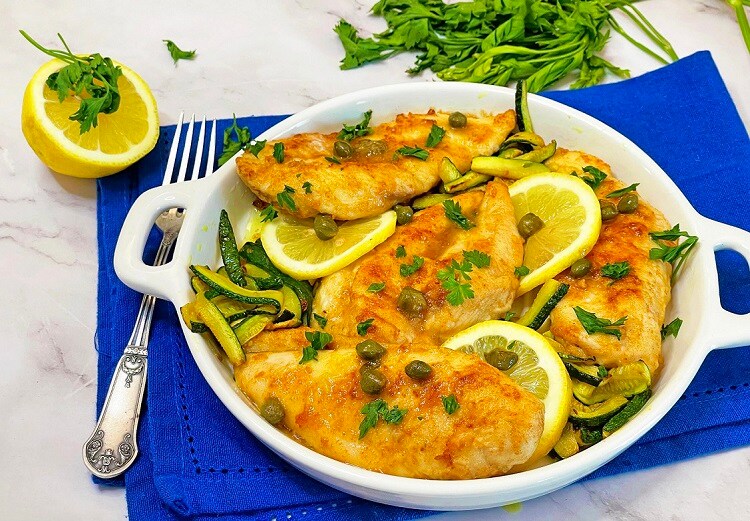LEMON CHICKEN BREAST
For a weekday dinner, if you don’t know what to prepare and you’re tired of the usual chicken breast slice, choose Lemon Chicken Scaloppine, an easy recipe for a simple and genuine main course that everyone will like.
Never take for granted the recipes considered more banal, like spaghetti with tomato sauce, lemon chicken breast is one of them.
A recipe made with ingredients we all have in the fridge or freezer, prepared with chicken meat that, if cooked properly, becomes incredibly tasty like with this lemon sauce.
It will only take you a few minutes to serve tender and juicy meat with a golden crust, accompanied by a delicious slightly tangy sauce.
Simple and few ingredients for a guaranteed success dish. Lemon chicken breast is an extremely easy recipe, perfect for everyday dinners, ready in no time.
There are many versions of Lemon Chicken Scaloppine. In the recipe I propose today, after many attempts, I tried to create the right balance between the acidity of the lemon, the saltiness of the capers, and the white wine to obtain a creamy and tasty sauce but not too acidic.
In just a few steps, you can create this delicious dish, a perfect recipe for both beginners and experienced cooks.
Related Recipes

- Difficulty: Very easy
- Cost: Economical
- Preparation time: 15 Minutes
- Portions: 4
- Cooking methods: Stove
- Cuisine: Italian
- Energy 304.52 (Kcal)
- Carbohydrates 17.40 (g) of which sugars 0.63 (g)
- Proteins 34.71 (g)
- Fat 10.58 (g) of which saturated 3.20 (g)of which unsaturated 1.72 (g)
- Fibers 0.80 (g)
- Sodium 571.14 (mg)
Indicative values for a portion of 160 g processed in an automated way starting from the nutritional information available on the CREA* and FoodData Central** databases. It is not food and / or nutritional advice.
* CREATES Food and Nutrition Research Center: https://www.crea.gov.it/alimenti-e-nutrizione https://www.alimentinutrizione.it ** U.S. Department of Agriculture, Agricultural Research Service. FoodData Central, 2019. https://fdc.nal.usda.gov
Ingredients
- 1.3 lbs chicken breast
- 3/4 cup all-purpose flour (for coating)
- 1/2 tsp salt
- 1/4 tsp black pepper (ground optional)
- 2 tbsps extra virgin olive oil
- 1 tbsp butter
- 1/4 cup dry white wine
- 2 tbsps lemon juice
- to taste capers (optional)
- 1 tbsp chopped parsley
Tools
- Pan
Steps
If you use a whole chicken breast, proceed as follows. First, divide the chicken breast in half, and before slicing, remove the wishbone at the top that connects the two halves. Once cut in two, also remove the central white cartilage. At this point, slice it, aiming to get slices of the same thickness and fairly thin.
On a cutting board, using a meat mallet, flatten the chicken slices to significantly reduce their thickness. Gently pound them and push the meat mallet outward to avoid tearing the flesh. Finely chop the parsley and set it aside. Place the flour on a plate and dip each chicken slice, pressing lightly to make the flour stick, and shake off the excess.
Heat 1 tbsp of butter and 2 1/2 tbsps of oil in a large pan until the butter has completely melted. Place the floured chicken slices and brown on both sides, turning them after a couple of minutes. Season with salt and pepper and, on high heat, deglaze with the white wine. Once the wine has evaporated, lower the heat and continue cooking for another 10 minutes, turning them occasionally.
Meanwhile, squeeze a lemon to get the juice and grate a little zest (only if the lemons are organic and untreated). Add the lemon juice and some capers to the pan in the last moments of chicken cooking. Sprinkle the scaloppine with some freshly chopped parsley, thickening the cooking base over high heat to form a delicious smooth and homogeneous cream. Serve the Lemon Chicken Breast hot with its sauce, flavoring with pepper and decorating with lemon slices.

NOTES AND SUBSTITUTIONS
CHICKEN You can buy the whole chicken breast and prepare it at home or have it prepared by the butcher or buy the pre-sliced cuts. Cooking times vary slightly depending on the thickness of the slices. Remember in any case that chicken, also for health reasons, must be perfectly cooked. If you have one, use a meat thermometer to check for doneness. The chicken must reach an internal temperature of 165 degrees to be cooked. You can also prepare this recipe with veal slices.
FLOUR Passing the chicken slices through the flour allows the meat to seal during cooking, remaining juicy inside and forming a delicious external crust.
BUTTER and OIL: I used a mix of oil and butter because the latter adds flavor to the chicken and creates a creamy sauce while the oil prevents the chicken from sticking to the pan.
WINE I recommend using dry white wine like Pinot Grigio or Chardonnay. You can skip the wine if you prefer and make the lemon chicken by replacing the alcohol with chicken broth.
LEMON JUICE Only use freshly squeezed lemon juice from organic lemons.
CAPERS If you want, you can add capers in the last minutes of cooking, which will add flavor and saltiness to the dish and compensate for the sour taste of the lemon. You can omit the capers if you don’t like them or replace them with olives.
GARLIC Some recipes include the addition of garlic; personally, I don’t like it, so I didn’t use it. If you like it, you can add it when preparing the sauce.
STORAGE
Lemon Chicken Scaloppine can be stored in the fridge in an airtight container for up to 2 days. Leftovers reheat very well in the microwave or on the stove. You can also freeze this preparation, and in this case, it keeps for up to 1 month. When you want to consume it, just defrost the chicken in the refrigerator and then put it in the microwave or oven.

